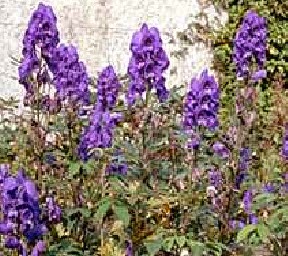Aconite
Aconite, common name for certain perennial herbs and for a preparation derived from them that was formerly used in medicine. More than 100 species belong to the aconite genus and are native to temperate regions of the northern hemisphere. Several species, including the helmet flower, a well-known European species, are cultivated as garden plants in the United States. The common aconites have fibrous or tuberous roots, mostly erect stems, and palmately divided or cleft leaves. The flowers in most species are blue or purple, although some species have yellow or white flowers. The outer, showy parts of the bilaterally symmetrical flower are five in number, and the uppermost is shaped like a large, downward-opening hood. Because of this hood, which immediately distinguishes aconite from larkspur, aconites are commonly called monkshood. They are also known as wolfsbane.
Aconites contain highly active alkaloids, especially aconitine, and are poisonous to both humans and animals. The helmet flower has long been considered one of the most dangerous plants of Europe. When eaten in small to moderate amounts, roots produce symptoms of restlessness, salivation, nausea, a weakened and irregular heartbeat, chest pain, prostration, and frequently death within hours.
Scientific classification: Aconites belong to the family Ranunculaceae. The helmet flower is classified as Aconitum napellus.
Related Articles: